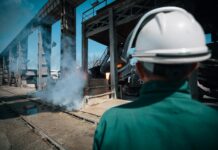Environmental groups have just published a stinging critique of the government’s strategy on Biomass with Carbon Capture and Storage (BECCS). They also have an ongoing legal case against the government on the same issue. We asked them why BECCS is so problematic.
“The whole thing is a total house of cards,” says Mary Booth of the Partnership for Policy Integrity. Her organisation is part of the Forest Litigation Collaborative (FLC) which is supporting a legal challenge against the UK government for its biomass strategy. The action is brought by The Lifescape Project, the other co-founder of the FLC. So what exactly is the problem?
“Negative emissions”?
As part of its work towards net zero, the government is continually seeking greenhouse gas removal vehicles (GGRs). The biomass strategy, published in August 2023, says that BECCS can be a GGR if deployed in the right way. The logic: plant growth naturally removes carbon from the atmosphere. So using the resulting biomass as a fuel source means that the emissions are balanced by the carbon the plant has already absorbed. Even though burning wood emits more carbon dioxide than coal per unit of energy, government policies consider bioenergy as “carbon neutral”. So, the theory goes, if you then add carbon capture and storage into the mix, you get net negative emissions.
“It’s about what emissions are going into the atmosphere right now.”
“The problem is, bioenergy isn’t carbon neutral,” Booth told the Energy Advice Hub. “Yes, trees have already absorbed carbon as they’re growing, but that would be true of coal. It doesn’t matter when the carbon was previously sequestered. It’s about what emissions are going into the atmosphere right now. Treating biomass as zero emissions is inherently misleading because it takes decades, maybe centuries, to regrow forest. If you’re releasing the carbon today, you can’t claim to be having no impact on the atmosphere unless you immediately sequester the same amount of carbon. And by extension, nothing about storing tree carbon below ground using CCS removes more CO2 from the atmosphere.”
Higher criteria won’t cut it
To class biomass as carbon neutral, the UK government is relying on an accounting convention from the Intergovernmental Panel on Climate Change (IPCC). This says that you can treat the emissions from one sector as zero if they have already been accounted for in another. So if the emissions impact of chopping down a forest has already been accounted for in the land use sector of the source country, it can be treated as zero in the energy sector. The problem? Much of the biomass burned in the UK is imported, some from countries with poor environmental standards. But it still gets treated as zero emissions in the UK energy sector and the UK land sector.
Before publishing the Biomass Strategy, the government commissioned a report from a Task and Finish Group within the Department for Energy Security and Net Zero (DESNZ). The main job of the taskforce was to establish whether or not BECCS can deliver net negative emissions. Its headline conclusion: it all depends on how you manage the value chain. “It is therefore important to quantify and minimise carbon leakage across the biomass supply chain.”
“You can’t change the simple physical fact that cutting down a tree and burning it emits carbon.”
Booth disagrees. “There are no criteria or restrictions that could change the simple physical fact that cutting down a tree and burning it emits carbon to the atmosphere, and the trees don’t grow back overnight.”
The issue of land use
Land use and land use change is one of the thorniest issues facing the government as it works to meet its climate goals. A former civil servant who worked at the Department for Environment, Food & Rural Affairs and the Department of Energy and Climate Change, who asked not to be named, told the Energy Advice Hub: “It is extremely complex to deliver a net zero energy and industrial system. But that complexity is as nothing compared to tracking emissions (and removals) from land and agriculture, let alone addressing them.”
Clearly, cutting down forests and replacing them with energy crops means losing a carbon sink and also releasing carbon into the atmosphere if and when that wood is burned. But, as Booth explains, indirect land use change is a problem too. “If you displace food crops with energy crops, we still need food. So someone goes and cuts down a forest to replace that food-growing capacity. And it’s very often in a poorly regulated country like Brazil.”
The UK’s Bioenergy Resource Model, published in August 2024, anticipates a scaling up of BECCS and the importing of energy crops and agricultural residues. Booth describes the list of countries as “bizarre: Brazil, North Korea, Afghanistan. And they have said that there’s no risk of land use change. So they’re counting all the biomass as zero even though they are proposing a massive upscaling of the amount of biomass imported. Which would definitely drive land use change, and they’re still counting it all as zero emissions.”
Drax: a cautionary tale
The UK’s largest power station serves as an example of how biomass energy can harm the planet even when importing feedstock from a country with high environmental standards. Drax in North Yorkshire has been moving away from coal, converting four of its six boilers to biomass burning. This takes the form of wood pellets from Canada and the US.
A Panorama investigation in October 2022 found that environmentally important forests were being cut down to be burned at Drax. An investigation by Land and Climate Review, published in May 2024, found that businesses in the Drax Group supply chain had broken Canada’s environmental laws on 189 separate occasions. (Drax took over pellet producer Pinnacle Renewable Energy in April 2021 and is now therefore directly responsible for any breaching of regulations by that company.) Yet the company has received billions of pounds in green energy subsidies from the UK taxpayer.
Further concerns
Lifescape’s case against the government points out many other questionable assumptions behind the biomass strategy. These include:
- Projecting a massive global increase in energy crops and crop yields generally (at a time when climate change threatens food stability);
- Not taking into account indirect land use change emissions;
- Assuming that most biomass from the UK in future will be energy crops and agricultural waste, when currently most biomass plants are configured to burn wood pellets;
- Assuming that all technical challenges relating to the storage of CO2 underground will be overcome.
The current government’s position
The biomass strategy in its current form is the work of the previous Conservative government. It is not yet clear whether the current government will continue with it. A spokesperson for the Department for Energy Security and Net Zero told the Hub: “The government only supports biomass, from domestic and imported sources, that meets sustainability criteria. The current subsidies for large-scale biomass generators will end in 2027.
“We are reviewing evidence gathered through a consultation on a potential transitional support mechanism for large-scale biomass electricity generators. No decisions have been taken as to whether any transitional arrangements will be put in place, or the form they would take.”
As of September 2024, the legal case is still pending.













